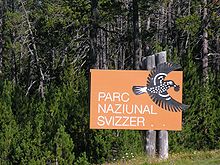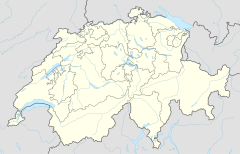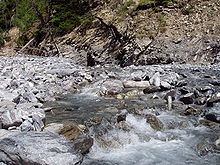Swiss National Park
| Swiss National Park | ||
|---|---|---|
| View from the Ofen Pass into the National Park towards Zernez | ||
|
|
||
| Location: | Graubünden , Switzerland | |
| Next city: | Zernez | |
| Surface: | 170 km² | |
| Founding: | 1914 | |
| Location in the canton of Graubünden | ||
The Swiss National Park ( Romansh : , Italian Parco Nazionale Svizzero , French Parc National Suisse ) is located in the canton of Graubünden in the easternmost corner of Switzerland in the Zernez - S-chanf - Ofenpass - Scuol area in the Engadin . It lies on the soil of the municipalities of Zernez (share 116.82 km² = 68.6%), S-chanf (share 23 km² = 13.5%), Scuol (share 22.48 km² = 13.2%) and Val Müstair (8 km² share = 4.7%).
According to the International Union for Conservation of Nature ( IUCN ), the Swiss National Park is a category Ia reserve (highest protection class, wilderness area). Founded in 1914, it is the oldest national park in the Alps and Central Europe.
He is a 1979 UNESCO - Biosphere Reserve and its present area of 170.3 square kilometers, the largest nature reserve at the same time in the country. It is run by a public foundation based in Bern. The administration is based in Schloss Planta-Wildenberg in Zernez. Ruedi Haller has been the director of the Swiss National Park since October 2019.
The national park covers altitudes from 1400 to 3174 m above sea level. M. ( Piz Pisoc ), the majority is in the subalpine level . A third of the park area is covered by forest, 20% by Alps and meadows, the rest consists of vegetation-free areas: rock, scree, snow, ice and water. Mountain pines and laying pines are the dominant tree species with 90%, a quarter of the tree population consists of dead wood - and the trend is rising, as rotting can take over 100 years. The park is mostly on Engadine dolomite and is therefore rather dry. The annual average temperature is 0 ° C, the annual precipitation around 1140 mm, the number of hours of sunshine in the year around 1900.
Goals of the national park

The only national park in Switzerland to date has three objectives: nature conservation, research and information. The fourth result is the introduction of the visitor to practical nature conservation using the example of a total reserve.
First and foremost is the idea of comprehensive nature conservation. In the park nature is left to its unrestricted development; It is not allowed to leave the marked paths, to take something home with you, to store it, to light a fire or to spend the night, nor are animals hunted, trees cut down or meadows mowed. In the long term, those conditions should be achieved again as they prevailed everywhere before the arrival of humans around 5000 years ago. Humans should only remain observers on given paths so that the impressive alpine landscape can develop in its own dynamic processes. Although the Ofenpass road leads through the park into the Vinschgau , large areas can only be reached on foot and several of the more than 20 valleys are completely closed to people. Among other things, they serve as resting areas for the game.
Nature observation
The fact that it is forbidden to leave the paths in the park means, among other things, that the animals get used to the people and can therefore be observed even at short distances. If you stay calm, you can observe ibex , red deer , chamois , marmots , roe deer, mountain hares, lizards, snakes, insects and many birds, maybe even one of the bearded vultures that were reintroduced in the park in 1991. Since there are now natural breeding in the area, the release of breeding animals was suspended in 2007.
The park's ecosystem comprises a total of several thousand animal and plant species, from inconspicuous microorganisms to the brown bear , which was spotted again in Switzerland at the end of July 2005 after around 90 years of absence. It seems that he immigrated to the national park from South Tyrol . As a migrant guest, he is seen as part of a constantly developing ecosystem and is therefore not scared off. Instead, the information boards have been supplemented with recommendations for behavior in the event of an encounter with the bear. An encounter with wolves or lynxes, which occasionally appear in the park, is rather unlikely. The lush vegetation is easier to see. A large part of the park is on limestone, so limestone flora dominates in most areas. Most of the rocks in the park - sandstones, limestone and verrucano - are, like dolomite, sedimentary rocks . Crystalline rocks such as gneiss or amphibolite are only found in the Macun area .
research
Thanks to scientific research, it is possible to document the changes in the national park and to research them in the long term. The series “National Park Research in Switzerland” has published research results from the national park area since 1920. To date, 90 publications have appeared in this series. The National Park's Geographical Information System (GIS) was created in 1992 from an initiative of the Research Commission and the Geographical Institute of the University of Zurich. Extensive and valuable data series have emerged in the course of decades of national park research. These data are supplemented with current observations and further processed in the GIS. Long-term processes can thus be better documented and understood. In addition to nature conservation and research, national parks are playing an increasingly important role as educational institutions. The information offered by the National Park contributes to the visitors' understanding of nature. Among other things, the park currently has eight full-time parking attendants for this purpose.
In the visitor center in Zernez you can get information about the park, visit an accessible marmot den or find out about special natural phenomena in the park area. These include the dinosaur tracks on Piz dal Diavel , the rock glacier in Val Sassa and the solifluction soils in Val dal Botsch . Since May 2008 the national park has a new visitor center in Zernez with a comprehensive permanent exhibition on the nature of the national park.
history
Based on the thoughts and deeds of Johann Wilhelm Coaz , who is considered to be one of the main pioneers of the national park idea , at the beginning of the 20th century there were increasing voices in Switzerland who wanted to put a stop to the ongoing destruction of the country's last natural regions. The Federal Council commissioned a commission to propose suitable areas that should be as similar as possible to the original state. Soon the focus was on the Ofenpass region in Graubünden. Under the leadership of the Basel zoologist Paul Sarasin, members of the Swiss Natural Research Society, today's SCNAT , proposed Val Cluoza in 1908, which combined the desired properties to a large extent. The municipality of Zernez as the owner was all the more inclined as the region was of little agricultural value. After some of the surrounding valleys could also be leased, an easement contract was signed for 99 years in 1913 and the park opened the following year. At that time it comprised around 79 km² area, which already included the current core zones: Val Cluozza, Ofenpass area and Val Minger. The Federation for Nature Conservation in Switzerland (SBN), founded in 1909, paid the first costs.
The 1913 contract regulated the lease payments to the communities by the Confederation, long-term scientific research by the Natural Research Society and the expenses for supervision and operation by the SBN. When the latter could no longer cope with the costs incurred, the federal government took over this task and the national park was converted into a foundation.
In 1959 the federal resolution for the national park was revised. Since then, the contracts have been running for an unlimited period, the rent has been re-regulated and a ban on outdoor power lines has been issued. In addition, the use of hydropower is prohibited in the area other than the already existing ones, a reaction to the equalization basin of the Spöl power plants built from 1957 on the southern edge of the park, which has robbed the Spöl of a large part of its natural flow. In 1961, the previously penultimate enlargement and 'rounding off' of the park area took place in 2000, the most recent recording of the cirque lakes northeast meters from Macun, a high valley of Zernez to around 2600 level. The park suffered a loss of territory in 1936 when the lease for Val Tavrü could not be extended. In 1964, the zoologist Robert F. Schloeth was hired for the first time as a full-time director. During his tenure, the National Park House opened in 1968 and the nature trail on the Ofen Pass opened in 1976.
A rapid increase in flora and fauna was noted in the first few years after it was placed under protection; bears appeared in the park area several times from 1914 to 1916. The number of visitors fluctuated around 250 per year during this initial period. From 1920, the path connections in the park were expanded. There are now around 80 km of developed trails available, including two alpine routes .
Landscape of National Importance
In accordance with Article 5 of the Federal Act on Nature Conservation and Heritage Protection, Switzerland keeps a federal inventory of landscapes and natural monuments of national importance .
- No. 1915, name: Swiss National Park and peripheral areas , year of inclusion in the inventory: 1996, size: 29,249 ha - the region comprises large parts of the Sesvenna group
Problems of the national park
The park's problems are particularly related to its location and its relatively small size. The park was an insider tip for nature lovers until the end of the 1950s, but since then the number of visitors has increased to such an extent that many animals increasingly adopt a nocturnal way of life and are more difficult to observe. One example is Alp Grimmels near Ova Spin, where only marmots can be seen today, but no longer deer and chamois. In the very dry park area, the traces of human use are disappearing very slowly. In many of the former Alps, the typical cattle flora can still be found today instead of the natural grasslands . The traces of mining and lime kilns are only slowly covered by vegetation, as are old clearcuts. Immediately before the park opened, some of the proposed leasing communities had cut so inordinate amounts of wood that the negotiations almost failed.
Fires represent a considerable problem. Near the Hotel Il Fuorn, one can still see a fire devastation from 1951, because the humus layer, once destroyed, regenerates extremely slowly. In the course of the construction work on the equalization basin at Ova Spin, a forest fire broke out in 1962, which could only be stopped with firebreaks and which resulted in small fires for ten days. These fires raised the still-debated question of whether the park should really be kept free of all human interference, including those that protect it.
While the number of chamois has remained almost unchanged, the number of deer and roe deer has increased significantly since the park opened. Browsing damage occurs in particular due to the increased number of hoofed game in winter. The game population also repeatedly attracts poachers who take advantage of the park's location in the border area between Switzerland, Austria and Italy in order to evade persecution.
literature
- Willi Dolder : The Swiss National Park . Zurich: Silva, 1977
- Patrick Kupper: Creating Wilderness - A Transnational History of the Swiss National Park. Bern, Stuttgart, Vienna: Haupt Verlag, 2012.
- Robert Schloeth : The Swiss National Park. Official hiking guide, [Zernez]: Federal National Park Commission, 1968.
- Robert Schloeth: The uniqueness of an anthill. Diary from the Swiss National Park . Bern: Zytglogge, 1989
- Robert Schloeth: The Swiss National Park. A natural experience , Aarau 1989.
- Robert Schloeth and Jost Schneider (eds.): Life and survival, animals and plants in the Swiss National Park , St. Gallen: J. Schneider 2000 (video compact cassette).
Web links
- Martin Bundi: National Park. In: Historical Lexicon of Switzerland .
- Parc naziunal svizzer (official website, German)
- Legal information about the national park






